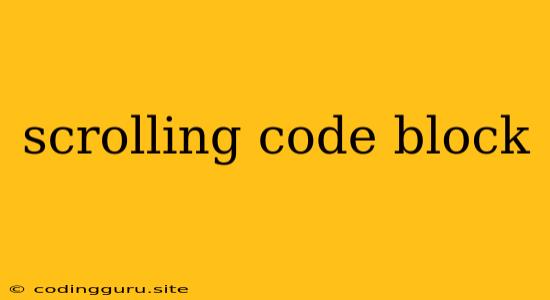Scrolling Code Blocks: A Developer's Best Friend
Have you ever found yourself staring at a long code block, struggling to scroll through it all? It can be a frustrating experience, especially when trying to understand a complex piece of code or locate a specific line. Fortunately, there are several ways to make code blocks more manageable and user-friendly: scrolling code blocks.
What are Scrolling Code Blocks?
Scrolling code blocks are a simple yet powerful feature that allows you to view large amounts of code within a confined space. They are essentially code blocks with built-in horizontal or vertical scrollbars, enabling you to navigate through the code without leaving the block itself.
Why Use Scrolling Code Blocks?
There are numerous reasons why scrolling code blocks are a valuable tool for developers and anyone working with code:
- Improved readability: By allowing users to scroll through code without expanding the entire block, scrolling code blocks improve readability and comprehension.
- Space efficiency: Instead of taking up excessive space on a page or screen, scrolling code blocks remain compact while still displaying all the code.
- Enhanced user experience: Scrolling code blocks offer a smooth and intuitive experience for navigating large amounts of code, making it easier to analyze and understand.
- Code sharing: When sharing code online, scrolling code blocks ensure that the entire code is viewable without requiring users to manually adjust window size.
- Accessibility: Scrolling code blocks improve accessibility for individuals who may have difficulty reading large blocks of text or code.
How to Implement Scrolling Code Blocks
Implementing scrolling code blocks depends on the platform or tool you are using. There are various solutions, from simple CSS styles to dedicated plugins and libraries. Here are a few common approaches:
1. CSS Overflow Property:
This is the most basic method for creating scrolling code blocks. By setting the overflow property of the code block to auto or scroll, you enable horizontal or vertical scrolling, respectively. For example:
.code-block {
overflow-x: auto; /* Enables horizontal scrolling */
overflow-y: auto; /* Enables vertical scrolling */
}
2. JavaScript Libraries:
Several JavaScript libraries offer more advanced features for creating scrolling code blocks, including syntax highlighting, line numbers, and custom scrollbars. Examples include:
- Prism.js: A popular syntax highlighting library that offers a built-in
scrolloption for code blocks. - Highlight.js: Similar to Prism.js, Highlight.js provides a scrolling functionality for code blocks.
3. Markdown Extensions:
Markdown editors often support extensions that allow you to easily create scrolling code blocks. These extensions typically offer syntax highlighting and other features, making it easier to manage and present code within a document.
4. Online Code Editors:
Many online code editors like CodePen, JSFiddle, and Repl.it automatically provide scrolling code blocks, allowing you to work with large code snippets without any extra configuration.
Benefits of Scrolling Code Blocks
Using scrolling code blocks provides numerous advantages for both developers and end-users:
- Enhanced Collaboration: Sharing code snippets with scrolling code blocks promotes clear communication and collaboration among team members.
- Improved Code Reviews: Developers can easily review code changes without having to scroll through an entire file, improving efficiency and focus.
- Better Code Documentation: Scrolling code blocks make it easier to include complex code examples in documentation, ensuring that all code is visible and understandable.
- Accessible Code: Scrolling code blocks are crucial for accessibility, allowing individuals with visual impairments or limitations to access and understand code.
Example: Using Scrolling Code Blocks in Markdown
Here's an example of how you can implement a scrolling code block in a Markdown document:
```python
# This is a long code block
# with multiple lines of code.
# This is an example of how to use scrolling code blocks.
def long_function(arg1, arg2, arg3):
"""This is a very long function that demonstrates the use of scrolling code blocks.
It takes three arguments and performs some complex operations.
"""
# Some code here
# More code here
# Even more code here
return result
Tips for Using Scrolling Code Blocks Effectively
Here are some tips to maximize the benefits of scrolling code blocks:
- Limit Code Block Size: Ideally, keep code blocks relatively small and break down large code segments into multiple, manageable blocks.
- Consider Context: Ensure that the context of the code is clear, especially when using scrolling code blocks for documentation.
- Use Syntax Highlighting: Highlight code with syntax highlighting to improve readability and comprehension.
- Include Line Numbers: Incorporate line numbers for easier navigation and referencing specific lines of code.
- Test Accessibility: Verify that scrolling code blocks are accessible to users with disabilities.
Conclusion
Scrolling code blocks are a valuable asset for anyone working with code. They enhance readability, efficiency, and collaboration, making it easier to manage and share code effectively. By implementing scrolling code blocks in your projects and documentation, you can improve the overall user experience and create a more accessible and inclusive environment for everyone.
